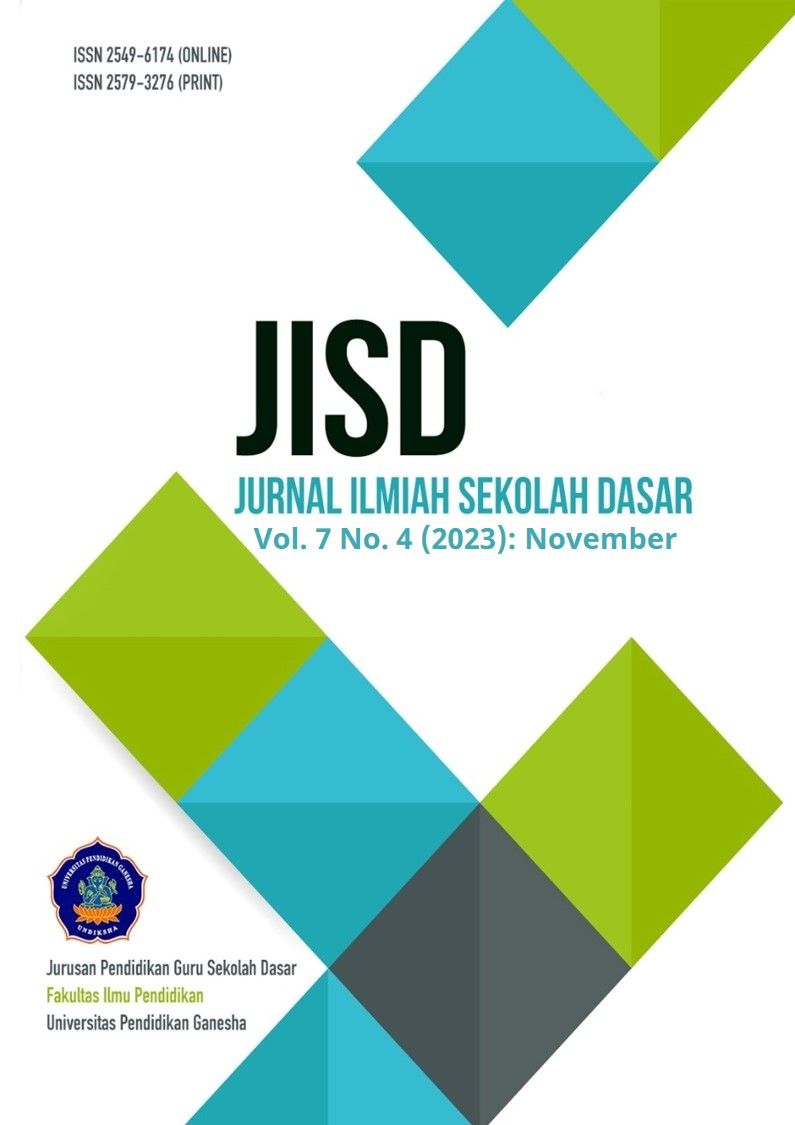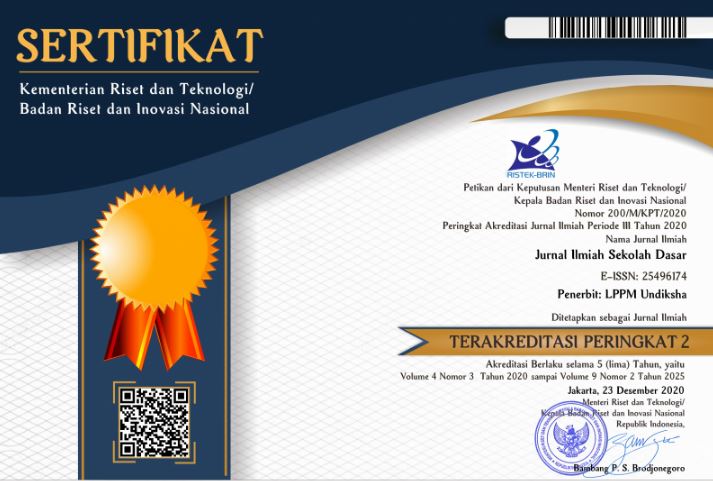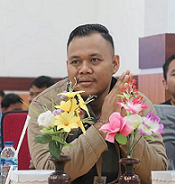Factors Affecting Elementary School Teacher Performance: A SEM-PLS Review
DOI:
https://doi.org/10.23887/jisd.v7i4.60626Keywords:
Prediction Factor, Teacher Performance, SEM-PLSAbstract
One important factor in improving the quality of education is teacher performance. However, teacher performance remains a problematic topic. This is particularly true when it comes to factors that technically affect their performance. Therefore, this study aimed to analyze factors that contribute most to teacher performance. This study was conducted using a correlational survey method. Data source in this study was 120 elementary school teachers participated voluntarily. The data were collected through an online questionnaire based on a Likert scale. They were processed using SEM-PLS. The results showed that the most influential factor in shaping teacher performance was competence. School climate, principal leadership and social influence have no significant relationship with teacher performance. Based on the results, improving competence is one effective to improve teacher performance. In addition, the other factors such as principal leadership, school climate, motivation, social influence, and teacher’s opportunity also affect teacher performance, albeit not significant. Through supportive school climate, high motivation and social support, teachers are hoped to show steady improvement to their performance. With better teacher performance it is hoped that educational progress will be achieved.
References
Afandi, M., Wahyuningsih, S., & Mayasari, L. I. (2021). Does elementary school teacher performance matter? Cakrawala Pendidikan, 40(1), 242–252. https://doi.org/10.21831/cp.v40i1.35284. DOI: https://doi.org/10.21831/cp.v40i1.35284
Amtu, O., Makulua, K., Matital, J., & Pattiruhu, C. M. (2020). Improving Student Learning Outcomes through School Culture, Work Motivation and Teacher Performance. International Journal of Instruction, 13(4), 885–902. https://doi.org/10.29333/iji.2020.13454a. DOI: https://doi.org/10.29333/iji.2020.13454a
Ansari, S. U., & Malik, S. K. (2013). Image of an Effective Teacher in 21 St Century Classroom. Journal of Educational and Instructional Studies in the World, 3(4), 61–68. https://www.researchgate.net/profile/sufiana-khatoon-malik/publication/274656383.
Apak, J., & Taat, M. S. (2018). Pengaruh kesediaan guru terhadap pengurusan bilik darjah abad ke-21. Malaysian Journal of Social Sciences and Humanities, 3(4), 6–22. http://msocialsciences.com/index.php/mjssh/article/view/103.
Cangur, S., & Ercan, I. (2015). Comparison of model fit indices used in structural equation modeling under multivariate normality. Journal of Modern Applied Statistical Methods, 14(1), 152–167. https://doi.org/10.22237/jmasm/1430453580. DOI: https://doi.org/10.22237/jmasm/1430453580
Ebele, U. F., & Olofu, P. A. (2017). Enhancing the standard of teaching and learning in the 21st century via qualitative school-based supervision in secondary schools in Abuja municipal area council (AMAC). International Journal of Educational Administration and Policy Studies, 9(6), 79–83. https://doi.org/10.5897/ijeaps2016.0490. DOI: https://doi.org/10.5897/IJEAPS2016.0490
Efendi, E., Harini, S., Simatupang, S., Silalahi, M., & Sudirman, A. (2021). Can Job Satisfaction Mediate the Relationship between Emotional Intelligence and Spiritual Intelligence on Teacher Performance? Journal of Education Research and Evaluation, 5(1), 136. https://doi.org/10.23887/jere.v5i1.31712. DOI: https://doi.org/10.23887/jere.v5i1.31712
Hair, J. F., Hult, G. T. M., & Ringle, C. M. (2017). A Primer on Partial Least Squares Structural Equation Modeling ( PLS-SEM ) (2nd ed.). SAGE Publications, Inc.
Harishree, C., & Mekala, S. (2020). Need for 21st century skills education for teachers. Roots International Journal of Multidisciplinary Researches, 7(1), 45–52. https://www.researchgate.net/profile/harishree-charath-chandran/publication/345733371.
Hendrawijaya, A. T., Hilmi, M. I., Hasan, F., Imsiyah, N., & Indrianti, D. T. (2020). Determinants of teacher performance with job satisfactions mediation. International Journal of Instruction, 13(3), 845–860. https://doi.org/10.29333/iji.2020.13356a. DOI: https://doi.org/10.29333/iji.2020.13356a
Indajang, K., Halim, F., & Sudirman, A. (2021). The Effectiveness of Teacher Performance in Terms of the Aspects of Principal Leadership , Organizational Culture , and Teacher Competence. Proceedings of the 2nd Annual Conference on Blended Learning, Educational Technology and Innovation (ACBLETI 2020), 560(Acbleti 2020), 402–408. https://www.atlantis-press.com/article/125957871.pdf. DOI: https://doi.org/10.2991/assehr.k.210615.078
Jardilino, J. R. L., Sampaio, A. M. M., & Oliveri, A. M. R. (2021). Teacher Performance Evaluation: to blame, punish or develop professionally? Ensaio, 29(111), 318–337. https://doi.org/10.1590/S0104-40362021002902701. DOI: https://doi.org/10.1590/s0104-40362021002902701
Kanya, N., Fathoni, A. B., & Ramdani, Z. (2021). Factors affecting teacher performance. International Journal of Evaluation and Research in Education, 10(4), 1462–1468. https://doi.org/10.11591/IJERE.V10I4.21693. DOI: https://doi.org/10.11591/ijere.v10i4.21693
Khun-inkeeree, H., Dali, P. D., Daud, Y., Fauzee, M. S. O., & Khalid, R. (2019). Effects of Teaching and Learning Supervision on Teachers Attitudes to Supervision at Secondary School in Kubang Pasu District, Kedah. International Journal of Instruction, 12(1), 1335–1350. https://doi.org/10.29333/iji.2019.12185a. DOI: https://doi.org/10.29333/iji.2019.12185a
Kline, R. B. (2011). Principles and practice of structural equation modeling. In The Guilford Press (Vol. 245). The Guilford Press. https://doi.org/10.1097/00003086-198908000-00042. DOI: https://doi.org/10.1097/00003086-198908000-00042
Kwong, K., & Wong, K. (2013). 28/05 - Partial Least Squares Structural Equation Modeling (PLS-SEM) Techniques Using SmartPLS. Marketing Bulletin, 24(1), 1–32. https://www.academia.edu/download/39627062/2013_journal_10_PLS_MB.pdf.
Leguina, A. (2015). A primer on partial least squares structural equation modeling (PLS-SEM). International Journal of Research & Method in Education, 38(2), 220–221. https://doi.org/10.1080/1743727x.2015.1005806. DOI: https://doi.org/10.1080/1743727X.2015.1005806
Mailool, J., Kartowagiran, B., Retnowati, T. H., Wening, S., & Putranta, H. (2020). The effects of principal’s decision-making, organizational commitment and school climate on teacher performance in vocational high school based on teacher perceptions. European Journal of Educational Research, 9(4), 1675–1687. https://doi.org/10.12973/EU-JER.9.4.1675. DOI: https://doi.org/10.12973/eu-jer.9.4.1675
Marisa, M. (2021). Inovasi Kurikulum “Merdeka Belajar” di Era Society 5.0. Santhet: (Jurnal Sejarah, Pendidiikan Dan Humaniora), 5(1), 72. https://doi.org/10.36526/js.v3i2.e-ISSN.
Meidani, N. E., Makiabadi, H., Zabetipour, M., Abbasnejad, H., Firoozian Pooresfehani, A., & Shayesteh, S. (2022). Emo-Sensory Communication, Emo-Sensory Intelligence and Gender. Journal of Business, Communication & Technology, 1(2), 54–66. https://doi.org/10.56632/bct.2022.1206. DOI: https://doi.org/10.56632/bct.2022.1206
Nessipbayeva, O. (2019). The Competencies of the Modern Teacher. Pre-Service and In-Service Teacher Training, 148–154. https://eric.ed.gov/?id=ED567059.
Nurabadi, A., Irianto, J., Bafadal, I., Juharyanto, Gunawan, I., & Adha, M. A. (2021). The effect of instructional, transformational and spiritual leadership on elementary school teachers’ performance and students’ achievements. Cakrawala Pendidikan, 40(1), 17–31. https://doi.org/10.21831/cp.v40i1.35641. DOI: https://doi.org/10.21831/cp.v40i1.35641
Phytanza, D. T. P., & Burhaein, E. (2020). The effects of tenure, teacher certification, and work motivation on special needs teacher performance. Universal Journal of Educational Research, 8(9), 4348–4356. https://doi.org/10.13189/ujer.2020.080962. DOI: https://doi.org/10.13189/ujer.2020.080962
Pishghadam, R., Abdwani, T. Al, Ahari, M. K., Hasanzadeh, S., & Shayesteh, S. (2022). Introducing Metapathy as a Movement beyond Empathy: A Case of Socioeconomic Status. International Journal of Society, Culture and Language, 10(2), 35–49. https://doi.org/10.22034/ijscl.2022.252360.
Ringle, C. M., Sarstedt, M., Mitchell, R., & Gudergan, S. P. (2020). Partial least squares structural equation modeling in HRM research. International Journal of Human Resource Management, 31(12), 1617–1643. https://doi.org/10.1080/09585192.2017.1416655. DOI: https://doi.org/10.1080/09585192.2017.1416655
Saleem, A., Aslam, S., Yin, H. B., & Rao, C. (2020). Principal leadership styles and teacher job performance: Viewpoint of middle management. Sustainability (Switzerland), 12(8), 1–15. https://doi.org/10.3390/SU12083390. DOI: https://doi.org/10.3390/su12083390
Skourdoumbis, A. (2019). Theorising teacher performance dispositions in an age of audit. British Educational Research Journal, 45(1), 5–20. https://doi.org/10.1002/berj.3492. DOI: https://doi.org/10.1002/berj.3492
Sulaiman, J., & Ismail, S. N. (2020). Teacher competence and 21st century skills in transformation schools 2025 (TS25). Universal Journal of Educational Research, 8(8), 3536–3544. https://doi.org/10.13189/ujer.2020.080829. DOI: https://doi.org/10.13189/ujer.2020.080829
Suyanto, S. (2017). A reflection on the implementation of a new curriculum in Indonesia: A crucial problem on school readiness. AIP Conference Proceedings, 1868(1), 39–57. https://doi.org/10.1063/1.4995218. DOI: https://doi.org/10.1063/1.4995218
Wahab, J. A., Mansor, A. Z., Hussin, M., & Kumarasamy, S. (2020). Headmasters’ instructional leadership and its relationship with teachers performance. Universal Journal of Educational Research, 8(11 A), 97–102. https://doi.org/10.13189/ujer.2020.082112. DOI: https://doi.org/10.13189/ujer.2020.082112
Wijaya, T. T., Jiang, P., Mailizar, M., & Habibi, A. (2022). Predicting Factors Influencing Preservice Teachers’ Behavior Intention in the Implementation of STEM Education Using Partial Least Squares Approach. Sustainability (Switzerland), 14(16). https://doi.org/10.3390/su14169925. DOI: https://doi.org/10.3390/su14169925
Downloads
Published
How to Cite
Issue
Section
License
Copyright (c) 2023 Yunus Abidin, Teni Susanti

This work is licensed under a Creative Commons Attribution-ShareAlike 4.0 International License.
Authors who publish with the Journal Ilmiah Sekolah Dasar agree to the following terms:
- Authors retain copyright and grant the journal the right of first publication with the work simultaneously licensed under a Creative Commons Attribution License (CC BY-SA 4.0) that allows others to share the work with an acknowledgment of the work's authorship and initial publication in this journal.
- Authors are able to enter into separate, additional contractual arrangements for the non-exclusive distribution of the journal's published version of the work (e.g., post it to an institutional repository or publish it in a book), with an acknowledgment of its initial publication in this journal.
- Authors are permitted and encouraged to post their work online (e.g., in institutional repositories or on their website) prior to and during the submission process, as it can lead to productive exchanges, as well as earlier and greater citation of published work. (See The Effect of Open Access)










